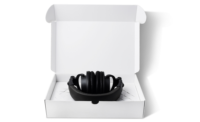Better With Less Finalists And Winners Share Insights & Inspiration

Sushi Take Away: Designed by Gerlinde Gruber, the objective was to meet the high demands of Japanese aesthetics and eating culture and to create an ecologically minded solution that is easy to use.

Stretching Inner Part: Designed by Iiro Numinen, this alternative to bubble wrap, was the winner, considered by the judges to be extremely appealing, versatile, scalable and easy to implement. Submitted in the e-commerce category, the corrugated box with an insert allows variable sized products to stay attached to the package during transportation without the need for plastic inserts of bubble wrap.

Eco Cake Tray: Designed by Insik Chung, the critical concept was the efficient use of resources while maintaining the convenience of usability. This idea could be applied to the other plastic disposable products that are used for everyday use, such as plastic forks, straws, etc.

Playing With Nature: Alessandro Grossi, the student winner, designed a snack packaging design that transforms into small finger puppets for children.

Moisture Face Cream Cosmetic Package: Designed by Abdullah Cam, and submitted in the cosmetics category, the re-usable paperboard package with a changeable plastic inner component makes plastic or foil coating unnecessary and recycling easier.





The inaugural Better With Less Design Challenge was created to find new environmentally friendly and functional packaging solutions for some of the world’s most frequently used and fastest growing types of consumer packages. Organized by Metsä Board, the European producer of premium fresh fiber paperboards, the submissions were judged by an international jury including renowned packaging design experts from various fields related to packaging, design, brand strategy and innovation. After the finalists were identified and the winners chosen, Metsä Board convened a Roundtable of the finalists and winners to get insights from these package designers on what motivated and inspired them to create these concepts and whether they believe these are going to motivate other companies to seek sustainable package design solutions.
WHAT WAS THE INITIAL IDEA FOR YOUR “BETTER WITH LESS” CONCEPT?
Alessandro Grossi - Playing Nature (snack design that converts to finger puppets)
I wanted to create a tool, rather than a box, that would help children to understand the importance of healthy nutrition. The best way to learn is by playing, especially when it comes to children. I wanted them to act and interact, to make them think about this topic. The shape of the packaging came later.
Insik Chung (ECO cake tray)
The goal was to reduce the use of disposable plastic products (i.e. disposable plastic spoons). So, the critical concept of ECO Cake Tray was the efficient use of resources while maintaining the convenience of usability.
Abdullah Cam & Dennis Lohmann (Moisture Face Creme cosmetic package)
The Cosmetics category held the biggest attraction to us because it consistently uses the most packaging resources -- one package for the product itself, one for the product package and then the plastic cover to protect the package and the product itself. For the purpose of reducing and recycling, we pared the package down to the minimum and made it easy to separate the different materials.
Gerlinde Gruber (Sushi take-out)
My main objective was to meet the high demands of Japanese aesthetics and eating culture and to proceed as ecologically as possible while enhancing the eating experience.
Iiro Numminen (Stretching inner part)
I’ve always been fascinated with the triangle as a form and had been testing different triangular cuts trying to come up with a good way to use it. I knew there was something interesting here, but I didn’t know how and where to apply the idea. For Metsä Board’s Better with Less Design, I realized that I could further develop it for an entry to the competition.
CAN THIS CONCEPT BE TRANSFERRED TO OTHER APPLICATIONS?
Alessandro Grossi: It can be used for every kind of snack that can be shared with friends.
Insik Chung: This idea could be applied to other plastic disposable products that are used for everyday use, such as plastic forks, straws, etc. For example, when buying a paper-cup packaged soup in a mart, a paper spoon can be attached to the package.
Abdullah Cam & Dennis Lohmann: You can easily transfer and scale the idea of the package for other products as well, like food (yogurts, sauces etc.) as well as for pet food.
Gerlinde Gruber: This special packaging design is mainly inspired by its content and use. But I think that the folding mechanism and the basic idea could also work for dumplings, etc.
WHAT DO YOU THINK THE FUTURE IS FOR THIS TYPE OF CONCEPT?
Alessandro Grossi: I think that instructive and ethical packaging will grow in popularity as it’s an essential issue nowadays.
Insik Chung: One of the principles of sustainable design is to hand over resources on this planet to the next generation. The use of plastics that threaten our environment must be reduced. For example, Starbucks is eliminating plastic straws and is replacing them with paper straws. Many other companies are involved in this movement.
Abdullah Cam & Dennis Lohmann: In the time since the design contest, we’ve had some discussions and requests about our idea, so we are hopeful that it will make its way into the market.
Gerlinde Gruber: I think that the design aspect will become increasingly important in the future—not only to stand out from the competition and appeal to the target consumer, but also to develop resource-saving packaging that is easy to dispose of and recycle. Smart solutions will be in demand.
Iiro Numminen: We have run several tests including a manufacturing test. Everything looks great so I believe there is huge potential for this idea to come to fruition. The structure is simple but diverse, and is scalable and easy to manufacture. Of course it might not be the right solution for all types of products and packaging solutions everywhere, but neither is the current alternative, bubble wrap. In addition to the customizability, the product is presented in a visually appealing way when unboxing and the inner part can be printed on, further highlighting the product or communicating the brand’s image to the end user. I think we are at the beginning of something bigger and if we can find right kind of implementation for the concept, it could end up becoming the standard in the packaging industry.
WHAT ARE THE MAIN CHALLENGES TO CREATING BEAUTIFUL AND FUNCTIONAL PACKAGING THAT’S ALSO SUSTAINABLE?
Alessandro Grossi: I think that if you divide ideas into more and less resource consuming ones it’s easier to focus on sustainable projects. Always start from an idea that you believe in and everything will be much more satisfying to design.
Insik Chung: Understanding the characteristics of the material is the most important consideration. I think that designers should keep studying to find the balance between aesthetically expressible range and functional packaging depending on the characteristics of the material.
Abdullah Cam & Dennis Lohmann: The difficult part is to come up with a solution for solving a problem. To make a package look good depends on the proportions and the forms, and then the branding elements on the package. Sustainability can be achieved with various easily recyclable materials or good separateable materials, like in our design.
Gerlinde Gruber: Especially in the case of food packaging, product and food safety comes first and secondly the idea of sustainability applies. I think that at the beginning of every packaging design project you have to keep both in mind right from the start.
Iiro Numminen: The most common aspects you have to take into consideration have to do with logistics, environmental footprint, brand communication, ease of use and the overall user experience. The designer has to be knowledgeable about the production process and overall life cycle of the packaging. In my opinion it also makes a big difference if you can minimize the energy used to produce the packaging and/or reduce the material used to a minimum.
If an idea is to be viable in a worldwide sense it has to be scalable and easy to produce. As a packaging designer, you make decisions (both professionally and as a consumer) that have an effect either locally or globally. You also carry a responsibility to minimize the negative effects of what happens when the packaging you’ve designed turns into waste. At the moment, the most environmentally impactful decisions are made when replacing plastic with other more bio-friendly alternatives.
The 2nd annual Better With Less Design Challenge is underway. Information about 2019 rules and entry deadlines will be announced spring 2019, with deadline for submissions slated for fall 2019.
Looking for a reprint of this article?
From high-res PDFs to custom plaques, order your copy today!













